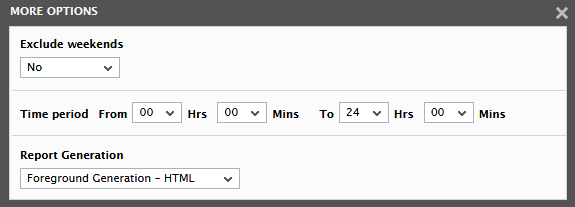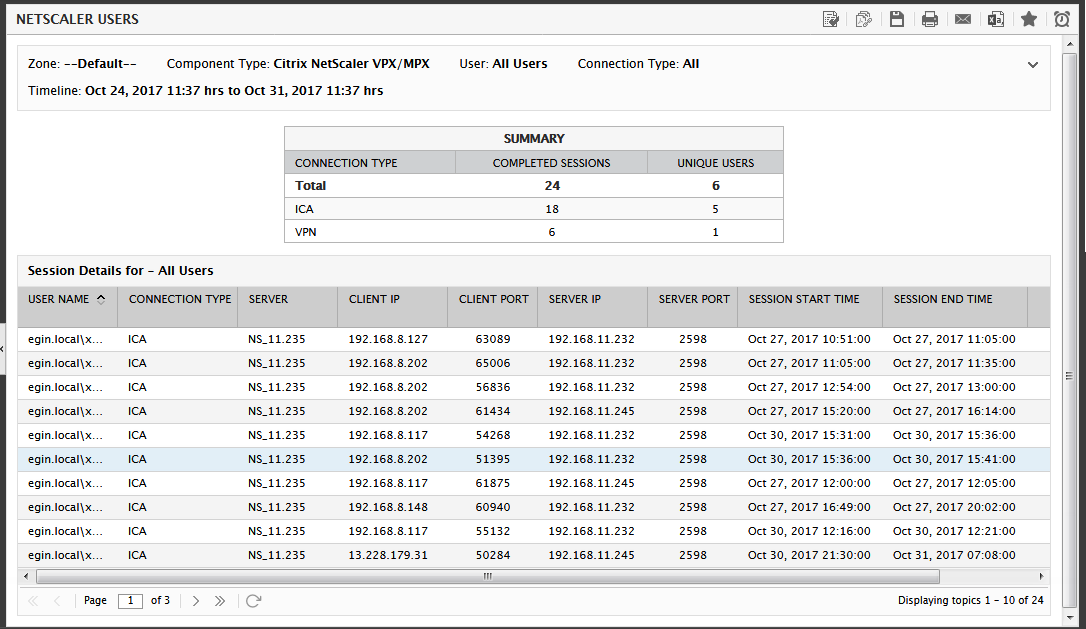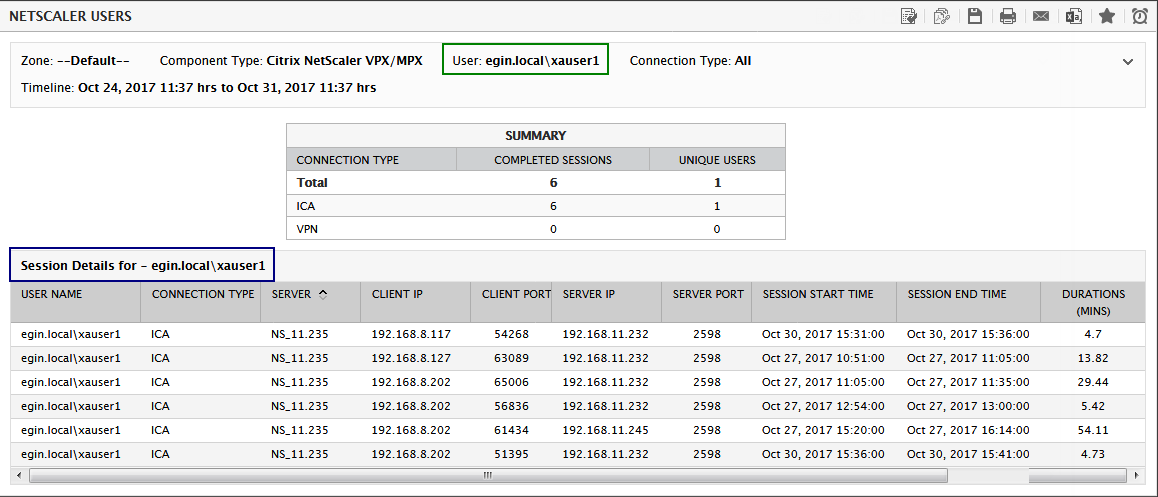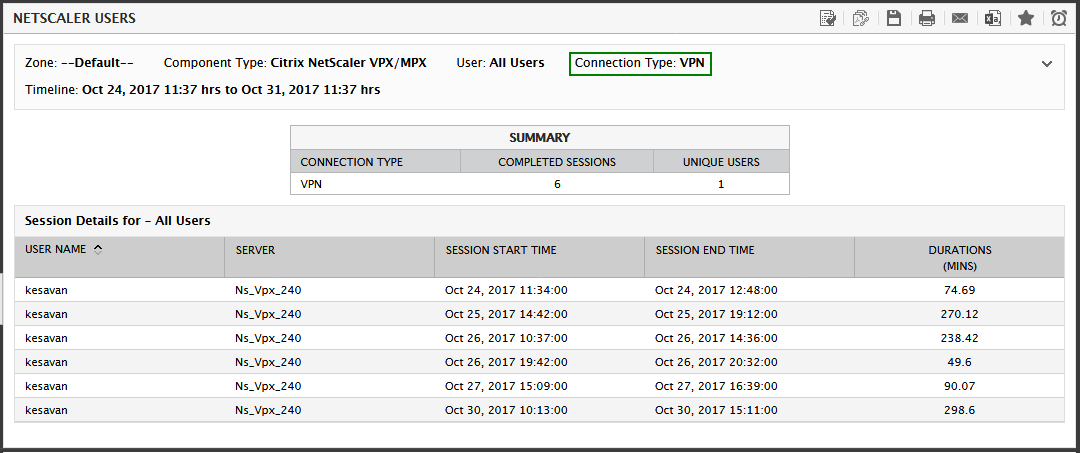NetScaler Users Report
In large Citrix environments, administrators may often want to obtain a historical analysis of the users who have initiated Citrix sessions through the NetScaler appliance. Administrators may also want to figure out the protocol (ICA or VPN) through which the users have initiated such sessions. By continuously analyzing the user activity through the NetScaler appliance, administrators may be in a better position to figure out the following:
- The session load on the NetScaler;
- If the user logins are sporadic or consistent;
- The unexpected logouts /abrupt session terminations;
- The unique users connected through each protocol;
The NetScaler Users Report offered by the eG Enterprise helps administrators in this regard!
To generate the NetScaler Users report, do the following:
- Select the NetScaler Users option from the Citrix/VDI Report node of the REPORTS BY FUNCTION tree.
-
Figure 1 will then appear.

Figure 1 : Specifying the criteria for the NetScaler Users report
-
To ease the pain involved in choosing the components for report generation, eG Enterprise provides a Report By list; by selecting an option from this list, you can quickly condense the Citrix NetScaler VPX/MPX component list and then swiftly identify the components of your interest. The options provided by the Report by list box are discussed hereunder:
- Zone: By default, the Zone option is chosen from the Report By list - this indicates that by default, the list will display all the managed Citrix NetScaler VPX/MPX components in the chosen zone. Select the zone to which the components of interest to you belong from the Zone drop-down list.
- Component: Select this option to generate a report on the users on all the Citrix NetScaler VPX/MPX components that are managed in the environment. A Component Type list then appears and is set to Citrix NetScaler VPX/MPX, by default. The components corresponding to the Citrix NetScaler VPX/MPX component type will be listed in the Components list. If the Components list consists of too many components, then viewing all the components and selecting the ones you need for report generation could require endless scrolling. To avoid this, you can click the
 button next to the Components list. The COMPONENTS pop up window will then appear using which you can view almost all the components in a single interface and Select the ones for which the report is to be generated. You can narrow your search further by using the Search text box. Specify the whole/part of the component name to search for in this text box, and click the
button next to the Components list. The COMPONENTS pop up window will then appear using which you can view almost all the components in a single interface and Select the ones for which the report is to be generated. You can narrow your search further by using the Search text box. Specify the whole/part of the component name to search for in this text box, and click the  icon next to it.
icon next to it. - Service: Select this option if the components for which a report is to be generated are involved in the delivery of a business service. Then, select a Service.
- Segment: Choose this option if the components to be evaluated are part of a segment. Then, pick a Segment for analysis.
- Next, select the type of connection using which the users are connected to the Citrix NetScaler VPX/MPX appliance from the Connection Type list. By default, the All option is displayed here, indicating that the report provides the details of the users connected using both the ICA and VPN protocols. However, if you wish to generate a report on the users connected using any one of the connection protocols, then, choose that particular protocol from this list.
- Then, select a user whose sessions should be generated as a report from the User list. By default, the All option is chosen here, indicating that the report provides the details of the sessions of all users to the Citrix NetScaler VPX /MPX component.
-
Then, specify the Timeline for generating the report. You can either provide a fixed time line such as 1 hour, 2 days, etc., or select the Any option from the list to provide a From and To date/time for report generation.
Note:
For every user registered with the eG Enterprise system, the administrator can indicate the maximum timeline for which that user can generate a report. Once the maximum timeline is set for a user, then, whenever that user logs into eG Reporter and attempts to generate a report, the Timeline list box in the report page will display options according to the maximum timeline setting of that user. For instance, if a user can generate a report for a maximum period of 3 days only, then 3 days will be the highest option displayed in the Timeline list - i.e., 3 days will be the last option in the fixed Timeline list. Similarly, if the user chooses the Any option from the Timeline list and proceeds to provide a start date and end date for report generation using the From and To specifications, eG Enterprise will first check if the user's Timeline specification conforms to his/her maximum timeline setting. If not, report generation will fail. For instance, for a user who is allowed to generate reports spanning over a maximum period of 3 days only, the difference between the From and To dates should never be over 3 days. If it is, then, upon clicking the Run Report button a message box will appear, prompting the user to change the From and To specification.
-
In addition to the settings discussed above, this report comes with a set of default specifications. These settings are hidden by default. If you do not want to override these default settings, then you can proceed to generate the report by clicking the Run Report button soon after you pick one/more components for report generation. However, if you want to view and then alter these settings (if required), click on the
 icon. The default settings will then appear in the MORE OPTIONS drop down window (see Figure 2). The steps below discuss each of these settings and how they can be customized.
icon. The default settings will then appear in the MORE OPTIONS drop down window (see Figure 2). The steps below discuss each of these settings and how they can be customized.
Figure 2 : The default settings for generating the NetScaler Users reports
-
If the timeline specified for the report needs to exclude the data collected during the Weekends, then set Exclude weekends to Yes. If not, select No.
Note:
You can configure the days of the week that need to be considered as a ‘weekend’ using the Days parameter in the[EXCLUDE_WEEKEND] section in the eg_report.ini file (in the <EG_INSTALL_DIR>\manager\config directory). The Days parameter is set to Saturday,Sunday by default. To change this weekend specification, enter two other days of the week against the Days parameter.
- Specify the start time and end time for report generation against the Time period field (see Figure 2).
-
In large environments, reports generated using months of data can take a long time to complete. Administrators now have the option of generating reports on-line or in the background. When a report is scheduled for background generation, administrators can proceed with their other monitoring, diagnosis, and reporting tasks, while the eG manager is processing the report. This saves the administrator valuable time. To schedule background processing of a report, you can either select the Background Save - PDF or the Background Save - CSV option from the Report Generation list. In this case, a Report Name text box will appear, where you would have to provide the name with which the report is to be saved in the background. To process reports in the foreground, select the Foreground Generation - HTML option from this list.
Note:
- The default selection in the Report Generation list will change according to the Timeline specified for the report. If the Timeline set is greater than or equal to the number of days specified against the MinDurationForReport parameter in the [BACKGROUND_PROCESS] section of the eg_report.ini file, then the default selection in the Report Generation list will be Background Save - PDF. On the other hand, if the Timeline set for the report is lesser than the value of the MinDurationForReport parameter, then the default selection in the Report Generation list will be Foreground. This is because, the MinDurationForReport setting governs when reports are to be processed in the background. By default, this parameter is set to 2 weeks - this indicates that by default, reports with a timeline of 2 weeks and above will be processed in the background.
- The Report Generation list will appear only if the EnableBackgroundReport flag in the [BACKGROUND_PROCESS] section of the eg_report.ini file (in the [EG_INSTALL_DIR]\manager\config directory) is set to Yes.
-
Finally, click the Run Report button to generate the report.

-
The generated report as shown in Figure 3, provides the following details:
- The report provides a Summary table that shows the type of connections, the total number of user sessions that were established via both the ICA and VPN protocols, the number of user sessions that were established via the ICA and the number of user sessions that were established via the VPN. This summary also provides the total and connection protocol wise count of unique users.
-
The Session Details for - All users section provides the following details:
- the name of the user;
- the connection type of each user;
- the server name;
- the IP address and the port number of the client;
- the IP address and the port number of the server;
- the start and end time of the user session;
- the time duration taken by a user to complete the session.
-
To generate a report on the sessions established by a particular user, choose that particular user name from the Users list in Figure 1. The NetScaler Users report will then appear as shown in Figure 4.

-
If you wish to view the details of the sessions established via a specific connection protocol, you can do so by choosing the type of the connection protocol from the Connection Type list in the Figure 1. The NetScaler Users report will then appear as shown in Figure 4.

Figure 5 : The NetScaler Users report for a specific connection type
The report that appears provides the following details;
- the number of user sessions established via the chosen protocol;
- the number of unique users who established sessions to the Citrix NetScaler VPX/MPX appliance using the chosen connection protocol;
- the name of the users who are all connected via the chosen protocol;
- the name of the server;
- the start and end time of the user session;
- the time duration taken by a user to complete the session.



